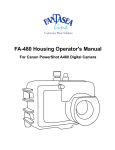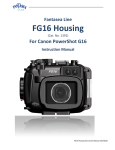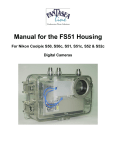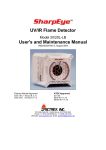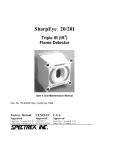Download Canon POWERSHOT FA-490 Instruction manual
Transcript
FA-490/495 Housing For Canon PowerShot A490 & A495 Digital Cameras Instruction Manual TABLE OF CONTENTS TABLE OF CONTENTS .......................................................................................................................................... 2 GENERAL INFORMATION ................................................................................................................................... 3 THE FANTASEA FA-490/495 HOUSING ................................................................................................................... 3 FANTASEA FA-490/495 USES ............................................................................................................................... 3 HOUSING PARTS ................................................................................................................................................. 4 GENERAL DESCRIPTION OF POWERSHOT A490 & A495 ............................................................................................. 9 USING THE FANTASEA FA-490/495 HOUSING ................................................................................................. 10 OPENING THE HOUSING ...................................................................................................................................... 10 INSERTING THE CAMERA ...................................................................................................................................... 10 CHECKING THE O-RING ........................................................................................................................................ 11 CLOSING THE HOUSING ....................................................................................................................................... 12 VIEWING THE SUBJECT ..................................................................................................................................... 13 TAKING THE PICTURE .......................................................................................................................................... 13 CHOOSING IMAGE FILES ...................................................................................................................................... 13 BATTERY LIFE .................................................................................................................................................... 14 USING THE FLASH ............................................................................................................................................. 14 ACCESSORY SLAVE FLASH ..................................................................................................................................... 15 LENS ACCESSORIES ............................................................................................................................................. 15 FANTASEA COMPACT DIGITAL HOUSINGS ACCESSORY SYSTEMS AND SETS ..................................................................... 16 SHOOTING TECHNIQUES .................................................................................................................................. 17 ZOOM CONTROL ................................................................................................................................................ 17 MACRO FOCUS .................................................................................................................................................. 17 QUICK REVIEW .................................................................................................................................................. 17 CAMERA STANDBY MODE .................................................................................................................................... 17 CARE & MAINTENANCE .................................................................................................................................... 18 2 GENERAL INFORMATION The Fantasea FA-490/495 Housing Fantasea has specially designed the FA-490/495 housing for the Canon PowerShot A490 and A495 digital cameras. This housing is ideal for outdoor and underwater photographers who enjoy the cameras automatic exposure features for capturing fast action pictures easily and creatively. The FA-490/495 housing ensures easy handling and accurate access to camera functions through the critical placement of push-button controls and a compact design. It is made of durable injection molded Polycarbonate and features a radial O-ring main seal, built-in flash diffuser, anti-glare hood over LCD screen, double O-rings on all controls, stainless steel buckles, a threaded port ring and a working depth of 200 feet/60 meters. The FA-490/495 housing provides access to all control functions: On/Off, Shutter Release, Shooting Mode, Zoom In/Out, Menu, Flash, Exposure Compensation, Timer, Macro, Playback and Delete. Fantasea FA-490/495 Uses The Fantasea FA-490/495 housing is designed as an underwater and outdoor camera housing. Underwater photographers can dive or snorkel and capture all the excitement of this fascinating world, while outdoor photographers also have the option of capturing the action of such activities as white water and paddle sports, swimming, sailing and boating, surfing, fishing and hunting, backpacking and camping. The Fantasea FA-490/495 will protect the camera from water, sand, dust, and other damaging elements. 3 HOUSING PARTS Top/Front Side of Housing 1. Shutter Release 2. Power On/Off 3. Removable Flash Diffuser 5. Buckles to Secure Housing 4. Lens Port Numbered description below refers to corresponding numbers on the top/front housing graphic. 1. Shutter Release This is a two stage shutter-release button. First lightly press the shutter-release button halfway, stopping when you feel minimal resistance. When the camera successfully focuses, it beeps twice. Press the shutter-release button the rest of the way down to release the shutter and take the picture. 4 2. Power On/Off To turn on the camera, press the power switch. The start-up image will display on the LCD monitor. To turn off the camera, press the power switch again. 3. Removable Flash Diffuser The Flash Diffuser is used to diffuse the internal flash's intensity. There are two different diffusers included with the FA-490/495 Housing: Transparent diffuser - this diffuser allows for a large amount of light to illuminate your subject, but doesn't reduce the shadowing effect when photographing from a short distance. Therefore, install this diffuser on the housing when taking wide angle shots and when the subject is positioned within a relatively far distance from the lens. White diffuser - this diffuser reduces the shadowing effect when photographing from a short distance, but allows for a relatively small amount of light to illuminate your subject. Therefore, install this diffuser on the housing when taking macro shots and when the subject is positioned within a close distance from the lens. Please refer to the "Accessory Slave Flashes" section for additional information. 4. Lens Port The housing lens port features a 46mm thread and is compatible with a wide variety of accessory filters and lenses. Please refer to the “Lens Accessories" section for useful information. 5. Buckles to Secure Housing The housing features 4 stainless steel buckles which ensure the housing is properly closed and watertight sealed. Please refer to the "Using the Fantasea FA-490/495 Housing" section for further information regarding opening and closing the camera housing. 5 Back Side of Housing 6. Zoom In/Out 11. Macro / Infinity / LEFT 7. Playback 8. Exposure Compensation / JUMP / UP 12. FUNC / Set 9. Flash RIGHT 10. Erase / Self-Timer / DOWN 14. Mode 13. Menu Numbered description below refers to corresponding numbers on the back housing graphic. 6. Zoom In/Out In the Shooting mode, pressing the right zoom button will zoom in on your subject, making it appear larger. Pressing the left zoom button will zoom out from your subject, making it appear smaller. In the Playback mode, press the right zoom button in order to magnify your image. Press the left zoom button in order to view images within an index view. 6 7. Playback In order to review images on the screen, press the Playback button. The last image taken will appear on the screen. Browse through the images using the multi-selector buttons. Pressing the Playback button again will turn the camera off. In order to switch to the Shooting mode, press the shutter-release button halfway. Multi-Selector buttons (8-12) 8. Exposure Compensation / JUMP / UP Exposure Compensation You can adjust the standard exposure set by the camera in 1/3-stop increments in the range of -2 to +2. Enter the Exposure Compensation mode by pushing the Exposure Compensation button. While watching the screen, press the left and right button to adjust the brightness and then press the FUNC / SET button. The Exposure Compensation amount will appear on the screen. Jump When there are many images on the memory card, you can search them by a specified method or image unit. In single image playback, press the Exposure Compensation / JUMP button. Press the up/down multi-selector buttons in order to select the desired search mode. Pressing the left/right multi-selector buttons will browse images by using the selected search method. To return to single image playback, press the Menu button. 9. Flash / RIGHT Press the Flash button. Use the multi-selector left/right arrows to choose the desired flash mode, and press FUNC / Set. 7 10. Erase / Self-Timer / DOWN Erase In the Playback mode, in order to erase an image, use the multi-selector right/left arrows to select an image and press the Erase button. Confirm that the erase is selected, and press the FUNC / Set button. Self-Timer In the Shooting mode, press the Erase / Self-Timer button in order to activate the Self-Timer. Use the multi-selector up/down arrows to select the desired mode and press the FUNC / Set button. Take a picture. 11. Macro / Infinity / LEFT Press the Macro / Infinity mode, use the multi-selector right/left arrows to select Normal, Macro or Infinity and press the FUNC / Set Button. Macro Close-Up mode is used for taking pictures of objects as close as 1cm/0.4 inch. Infinity mode is used for taking pictures of objects 3m/9.8 feet or more from the end of the lens. 12. FUNC / SET The FUNC / Set button sets many of the common shooting functions. Choose any of the shooting modes displayed when pressing the Mode button. Press the FUNC / Set button. Use the multi-selector up/down arrows to select a menu item. Use the multi-selector right/left arrows to select an option for the menu item. Press the FUNC / Set button again. 13. Menu Various settings for shooting, playback or printing can be set with these menus. Press the Menu button. Use the multi-selector left/right arrows to switch between menus. Use the multi-selector up/down arrows to select a menu item. 8 After selecting an item, use the multi-selector left/right arrows to select an option. Press the Menu button again. 14. Mode In order to switch between the different shooting modes, press the Mode button. Use the left/right multi-selector buttons to browse available shooting modes. Press the Func / Set button in order to confirm your selection. Note It is strongly recommended that you familiarize yourself with all the controls topside before using these controls underwater. GENERAL DESCRIPTION OF POWERSHOT A490 & A495 With their streamlined silhouette and smoothly-curved edges, the Canon PowerShot A490 and A495 have the compact sophistication and relaxed simplicity that make them a natural for beginners and everyone else who craves style and convenience. 10.0 Megapixel resolution and 3.3x Optical Zoom make it easy to capture the action in dazzling color and brilliant detail. The DIGIC III Image Processor keeps it all looking sharp. A bright, bold 2.5-inch LCD makes shooting and playback a genuine pleasure. Key Features Easy to use, powerful A-Series camera that has a 10.0 Megapixel and 3.3x Optical Zoom , which make picture taking a snap. Smart AUTO will do the work for you by intelligently selecting the proper settings for the camera based on 13 (A490) or 18 (A495) predefined shooting situations. 9 Low Light mode enables great shots in dimly lit situations, while Smart Flash Exposure technology enables the user to balance the flash to avoid over or under exposure. New Scene Modes - such as Super Vivid for additional bursts of color and Poster Effect for a unique artistic look, which give the shooters more creative freedom to capture images their way. Large, clear 2.5-inch LCD makes taking and viewing images a breeze. This AA battery-powered camera enables you to easily power up on the go. USING THE FANTASEA FA-490/495 HOUSING It is strongly recommended to take the first dive without the camera Note inside the housing. You should check that the watertight seal has not been affected during transport and long periods of storage. OPENING THE HOUSING 1. Release all four latches at the same time, and lift off the back half to open the housing. INSERTING THE CAMERA Since the Fantasea FA-490/495 is specifically designed for the PowerShot A490 & A495 digital cameras, inserting the camera into the housing is quite simple. 1. Mount the camera on the removable tray, using the mounting tripod screw. 2. Slide the tray and camera into the housing tray slot. Make sure it is completely inserted. 3. Make sure the camera lens is more or less centered in the rounded port area and that the lens does not distort the round black rubber seat. The housing is designed to have the camera fit in place perfectly, but if you are not careful, it is possible to put it in at an improper angle and it will then be impossible to establish a proper seal or easy closure of the housing. 10 4. After camera insertion, check that the extended camera lens does not catch or bend the black rubber seat on the inside of the lens port. It is vital that the lens does not disturb this rubber seat. 1. It is recommended to make some camera settings prior to inserting the camera into the housing. Please refer to the camera owner's manual for menu options and personal Note preferences. 2. Take a few test shots: it is recommended to turn the camera "on" and program to “Flash Always” mode before inserting it into the housing and then take test shots to make sure all systems are working. CHECKING THE O-RING Prior to each closure of the housing, the O-ring should be visually inspected. If there is any debris present, including dirt, sand, dust, hair, grease or other matter, it must be cleaned to ensure a proper watertight seal. Cleaning the O-ring is a simple matter of wiping it with a damp, soft cloth to remove the foreign matter. Be careful the cloth you use does not leave any of its own material behind as this can also affect the effectiveness of the seal. When replacing the O-ring, place it back into the groove starting at one corner and gently place it in by pressing it into the groove all around the housing until it is all sitting in the groove and no part of it is sticking up or out of the groove. You can then apply a slight layer of silicone if you have not done this yet. Be sure it is completely seated in the channel for a proper seal. Lubrication of an O-ring does not improve the seal. It only reduces the amount of friction on the O-ring when it is being moved into sealing position. The amount of lubrication required on the O-ring is only enough to allow it to slip Note into place without friction, so it does not twist or become dislodged. More grease is not better, and could in some cases have a negative affect if it is applied in large amounts to form a build-up that could trap any debris or foreign matter. 11 CLOSING THE HOUSING 1. Place the housing back over the front and align the complete mating surface of the housing and the O-ring, forming a proper seal. 2. Position all four latches over latch hooks in ready position. 3. Close one of the bottom latches first, maintaining pressure on the other side. Proceed by closing the other side's top latch. Then close the remaining bottom latch and the remaining top latch. Test all latches carefully to make sure that they are completely locked into place and not just pushed down. Try to open them to make sure that they cannot open accidentally. 4. Inspect the O-ring for proper closure. A complete seal can be visually confirmed by the O-ring around the complete circumference of the housing. 5. Always take the first dive without your camera in the housing just to make sure there is no leakage from damage to the housing. During the dive, especially at the beginning of descent, take special care to look at the housing to make sure no bubbles are escaping from it and that no water is entering. Generally, if there is a problem with the seal, you will discover it in the first seconds of the dive. 6. After use, when opening the housing, it is important to hold it so the lens port is facing down. This will prevent the camera from slipping out of the housing while being opened. Release the four latches in the same order described for closing them in step 3, and take off the back side of the housing. Gently pull both the tray and the camera outside of the housing and unscrew the tripod screw out of the camera in order to disconnect it from the tray. 12 VIEWING THE SUBJECT The A490/495 camera doesn’t have a standard eyepiece, but underwater photographers and outdoor photographers will appreciate the large LCD viewing monitor for composing photographs. The LCD monitor allows you to see your subject in sharp focus and framed properly. Hold the camera housing in your outstretched arm at a position that is both comfortable and also allows you to easily see the LCD monitor, for best compositional options. TAKING THE PICTURE Once you have composed your scene or subject in the LCD monitor, depress the shutter release button to take the picture. A half depress will activate the live viewing ability of the LCD and allow the camera to focus, once in focus and ready to shoot a green light will appear on the LCD monitor and the camera is ready to take the picture. Press down the shutter all the way to complete the image capture. You may notice a pre-flash and slight delay in the shutter release. This is to allow the camera to make its final focus and exposure calculations before taking the picture. With a little practice, you will become used to this and taking pictures of moving subjects will become easier and natural. CHOOSING IMAGE FILES There are several image file options to choose from that offer different resolutions and file sizes. This determination must be made prior to camera insertion from Menu options. Please refer to the camera instruction manual for details on setting these preferences. 13 BATTERY LIFE AA-Size Battery Compatibility AA-Size is one of the most widely available battery sizes in the world - in alkaline, lithium, rechargeable or other forms. AA compatibility enables use anywhere in the world. There are certain things that users can do to help with battery life. The most important is to set the camera to turn the LCD off after a short time, during periods of non-use. It can then be automatically turned back on if you depress the shutter release control half way. Please refer to the camera Instruction Manual for details on how to make this adjustment setting. It is always wise to have backup batteries in case you do run out of power. The supplied battery can be recharged many times and offers an economical and environmentally friendly power source. USING THE FLASH The A490/495 has a built-in flash, which will illuminate nearby underwater subjects. For subjects that are farther away, an accessory slave flash is recommended (see below). A built-in flash diffuser is supplied which will help achieve a wider and softer light source thereby providing more coverage and less likelihood of backscatter (the unattractive snowstorm affect of the flash reflecting off the suspended particles in the water). Further reduction of backscatter can be achieved by using an accessory off-camera slave flash. This will be discussed in more detail in the next section. The need for artificial light to maximize color reproduction is necessary in nearly all pictures. Therefore it is strongly recommended that you set the flash mode to Flash Always. This will ensure the flash fires on every exposure regardless of the ambient light conditions (Please refer to the camera instruction manual for more details). 14 ACCESSORY SLAVE FLASH If you use the camera built-in flash as the master, you can trigger a second slave flash to provide better artificial light when needed. To do this, you must use an accessory flash that has a slave feature built in. The flash from the camera must be aimed or bounced towards the accessory flash's slave sensor, or other fiber optic sensor. This will trigger the slave to fire in sync with the master flash. When using an accessory slave flash with fiber optic cable, it is recommended to black out the internal camera flash. The internal flash is located near the camera lens and can contribute to backscatter by illuminating floating particles close to the lens port or a shadowing effect caused by the lens port. If the sensor of the fiber optic cable is attached to the outside of the housing directly above the internal flash and taped over with black tape–it will block out the light from the internal flash but transmit the light pulse to the external slave flash. Fantasea Line offers the following underwater slave flashes compatible with this housing: Remora Flash (#6117)- Features a guide number of 20 and therefore compatible for both macro and wide angle photography. The Remora features a variable output control and a Y-S Mount which enables mounting a focus light on top of the flash, thereby eliminating the need for an additional arm. Nano Flash (#6115)- Features a guide number of 12 and therefore useful mainly for macro and general photography. The Nano Flash offers 3 output levels. Complete Lighting Sets- Include one of the slave flashes mentioned above, a tray & arm system, fiber optic cable, padded housing bag and a focus light. Note Be sure to use a slave flash that has the ability to ignore the built-in pre-flash in digital cameras, and synchronizes with the shutter release. LENS ACCESSORIES The Fantasea FA-490/495 features a threaded 46mm lens port. This threaded port is designed to work with some of the lens accessories that are currently on the market. Fantasea Line offers the following lens accessories compatible with this housing: BigEye Wide Angle Lens M46 (#5131): Perfect for shooting seascape, divers, ship wrecks and schools of fish, without moving further away from the subject, thereby still taking full advantage of 15 water clarity and artificial light sources. SharpEye Macro Lens M46 (#5127): Perfect for shooting close-up images of fish, corals, textures and more. This macro lens magnifies the subject and enables the camera to focus on short distances for creating super sharp images. RedEye Color Correction Filter M46 (#5178): Used to restore the red color absorbed by the water. In shallow depths, these filters can serve as an attractive alternative to artificial light sources. For more information on these items, see your local photo dealer or visit our website at www.fantasea.com FANTASEA COMPACT DIGITAL HOUSINGS ACCESSORY SYSTEMS AND SETS Fantasea offers a variety of sets for Fantasea and other housings. These sets are made up of quality accessory products which will enhance and improve your underwater images. Accessory products include external flash systems, flexible arms, trays, filters, wide angle lenses, fiber optic cables, bags and more. Below you can see one sample system. For more information please refer to our website or to the Fantasea Dealer where you purchased your housing. 16 SHOOTING TECHNIQUES ZOOM CONTROL Zoom in for telephoto photos and larger subject size. Zoom out for wide-angle scenes. It is generally not recommended to use the zoom underwater as it is preferable to get physically closer to your subject. The digital zoom has no value at all. MACRO FOCUS For capturing the tiny and exotic subjects that require close focus. Macro focus is possible when the lens is in the wide-angle position. QUICK REVIEW Immediate review of your most recent image is available and this will confirm that you have captured the shot you want. However, if you want to scroll through your images, or delete images from the memory card, this should be done when you are topside and the camera is out of the housing. CAMERA STANDBY MODE You can access the camera's menu to select the length of the inactivity period. Inactivity period is the length of time before the camera goes into standby mode. This feature allows you to conserve battery power by placing the LCD monitor on standby [sleep mode]. It is recommended that this option is set for 30 seconds to conserve battery power. If set for longer periods of time the LCD screen will heat up and it will produce condensation and fogging of the lens port. Condensation on the lens port will have a negative impact on the quality of the images taken. When you want to resume shooting, pressing the shutter release half-way will re-activate the camera. However, if after the camera goes into standby, a further period of three minutes goes by without any activity, the camera will turn off [deep sleep mode]. You can turn it back on by pressing the On/Off Power button. The Welcome screen will appear and then it will display the last image taken. 17 CARE & MAINTENANCE The Fantasea FA-490/495 housing requires only a minimum amount of care for reliable performance. The following tips will enable you to get the best results: 1. Always rinse your housing with a strong stream of fresh water and if possible soak the housing in a fresh water tub or rinse tank for about 20 minutes after every dive in order to dissolve the salt water crystals from around the controls and openings of the housing. Manipulate each of the movable controls to assist the removal of salt particles from these tight areas. 2. Allow the housing to dry thoroughly before packing away for the day or for the trip home. You may use a soft towel or cloth to dry the housing. Be sure there is no grease or other debris on the towel. 3. Visually check the condition of the O-ring before every dive. If it is dirty, clean it with fresh water and dry it with a soft cloth as described above. If it is damaged in any way, such as cut or perforated, replace it before using the housing again. 4. It is recommended to slightly lubricate the housing's O-ring periodically. It's important to note that the amount of lubrication required on the O-ring is only enough to allow it to slip into place without friction, so it does not twist or become dislodged. More grease is not better, and could in some cases have a negative affect if it is applied in large amounts to form a build-up that could trap any debris or foreign matter. 5. Be careful not to get greasy fingerprints or dirt on the lens port. This will affect the image quality. Wipe any dirt or grease off with fresh water and a soft cloth. 6. Do not drop the housing on hard surfaces, it could crack and affect its watertight seal integrity. 7. Travel with the housing protected in a padded case. It is best to remove the camera from inside the housing when traveling and provide it with its own protective case, or compartment. 8. Never dive with the Fantasea FA-490/495 housing to a depth greater than 200 ft/60 meters. 9. It is recommended that you select the shortest time option on the menu, for placing the camera into standby during periods of inactivity. This will conserve battery power and reduce 18 the heat given off by the LCD screen, which can contribute to condensation inside the housing and fogging. 10. You should take the first dive without the camera inside the housing. You should check that the water tight seal has not been affected during transport and long periods of storage. 11. It is likewise recommended to visually monitor the housing during every descent, especially for the first 10 meters/33 ft. If water is observed entering the housing or bubbles escaping from it, the housing should be rotated to a port down position and held that way as you return to the surface immediately and get it out of the water. 12. It is recommended to have all Fantasea housings serviced once a year at an authorized Service Center. This includes visual inspection and possible changing of all seals, gaskets and O-rings. Please contact Fantasea by email at [email protected], or visit the Fantasea web site www.fantasea.com for more information. 19



















